Recent painting graduate from The Glasgow School of Art, Laura Campbell has written the following review of the current Mackintosh Museum exhibition, A conspiracy of detail.
To visit the Mackintosh Museum during The Glasgow School of Art’s current exhibition, A conspiracy of detail, is to find yourself stepping into a cabinet of curiosities occupied by artefacts and trinkets that might have originated from any number of exotic places and, seemingly, from any period in time. This feeling of eclecticism is accented by the show’s environment: Charles Rennie Mackintosh’s exquisitely rendered arts and crafts style museum space complements the theme of the exhibition. As the title of the show suggests, the chosen artworks are devious in their presentation. There are sculptures feigning a crumbling, timeworn appearance, a heavy-looking head that is in fact made from play dough and even a set of sculptures posing as brilliantly preserved futuristic tools. Stained, worn, dirty, gleaming, glossy, matte, threadbare- this is an exhibition that really does celebrate art’s relationship with materiality and craftsmanship.
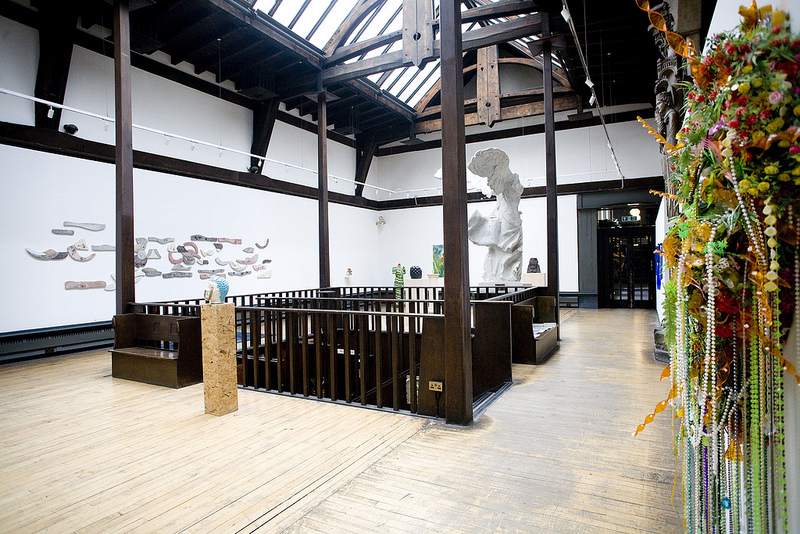
Installation view, image courtesy The Glasgow School of Art, photograph by Janet Wilson
A conspiracy of detail comes at a time when many of us are struggling with the notion of authenticity and when substance is all too often overruled by style. Quantifying material value in the 21st century is difficult namely because many of the things we now value are immaterial or are caught up in the cycle of fashion. This dematerialisation of our world could also account for the more recent fetishisation of materials in the plastic arts (think of the notable resurgence in oil painting). The Glasgow School of Art’s latest exhibition is a refreshing and vital look at materials and the values we invest in them.
A combination of national and international artists has been selected for the show for whom ‘adornment’ and unconventional materials are important. For these artists the magic is in the finer details. The exhibition boasts GSA alumni, Alex Pollard, Jim Lambie and Pio Abad, as well as internationally renowned Hew Locke, Karin Ruggaber, Eva Rothschild, Jonathon Baldock and Renee So.
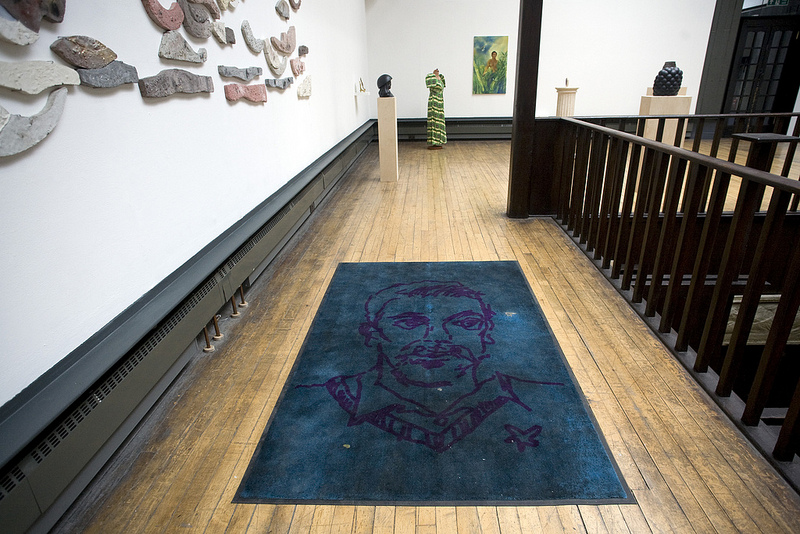
Alex Pollard, image courtesy The Glasgow School of Art, photograph by Janet Wilson
Alex Pollard and Jim Lambie’s works are imbued with a sly, deadpan humour. Whilst visitors will be suppressing the urge to touch the very tactile artworks on display in this show, Pollard flips gallery etiquette on its head, allowing visitors to literally trample all over him (or his portrait at least). The work, which takes the form of a giant, soiled doormat, features a roughly sketched portrait of the artist. Things become complicated once it is understood that the curator of the exhibition, Jenny Brownrigg, made the initial sketch. By engaging with the politics of the art world and questioning the hierarchy of roles within it, Alex Pollard poses difficult questions about originality and authenticity. Similarly, Jim Lambie, who has a history of working with everyday objects such as belts and handbags, turns his attention towards the art world itself. With tongue firmly in cheek, the former Turner Prize nominee offers up an oversized gold-plated belt, perhaps mocking an art market that sees artwork in monetary terms.
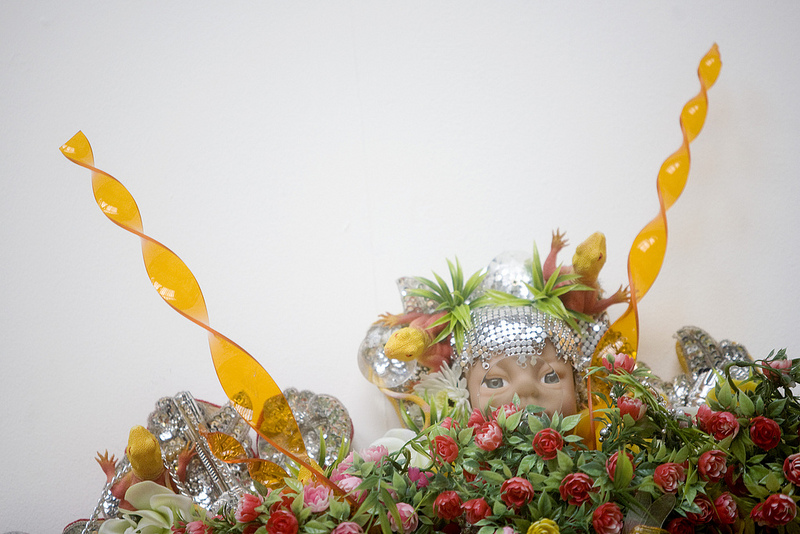
Hew Locke, image courtesy The Glasgow School of Art, photograph by Janet Wilson
Hew Locke doesn’t use gold, but cheap and vibrant plastic knick-knacks to create his portrait of the Queen. Up close, ‘Demeter’ resembles a snowball that has gathered pace in a pound shop. Stepping back, one can see the monarch’s profile lurking within the psychedelic madness. Locke responds to global power structures, in this case the lasting influence of the monarchy, with a personal and shrewd fervour. ‘Demeter’ comes as a welcome antidote to the hysteria surrounding the recent addition to the royal family.
Also using embellishment to political ends, GSA alumnus, Pio Abad has installed a pseudo-museum: an arrangement of real and fabricated ‘artefacts’ addressing Ferdinand and Imelda Marco’s tyrannous rule in the Philippines, where Abad was born. Like ‘Demeter’, Abad’s installation draws our attention to the less palatable aspects of power by utilising irony. The cheerfully coloured pop objects are accompanied by a text written by the artist, revealing the sinister narratives behind the work. Pio Abad’s cool and critical response to these outrageous historical figures is both commendable and powerful.
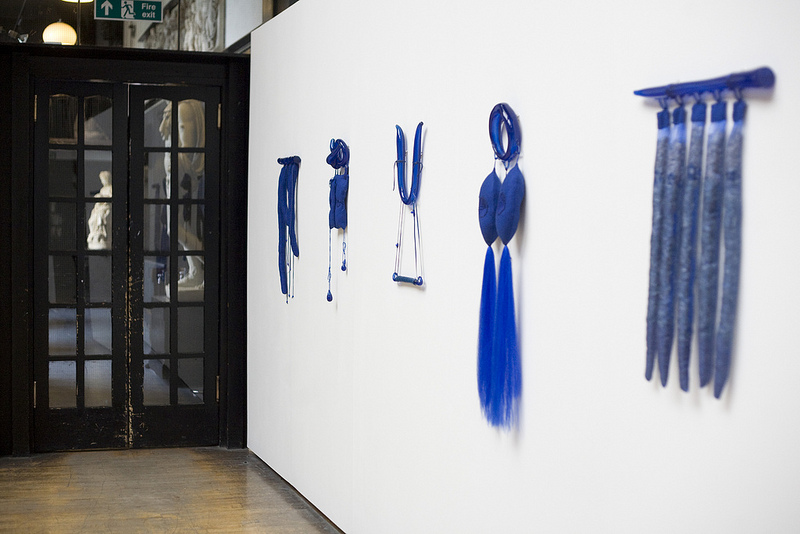
Jonathan Badlock, image courtesy The Glasgow School of Art, photograph by Janet Wilson
Like Pio Abad, Renee So and Jonathon Baldock are inspired by the past, be it historical myth or fact. The exhibition features elegantly crafted heads from both artists, but it is Baldock’s ‘Sacred Letter Tools’ that is the highlight of the show. Beautiful objects in Yves Klein blue adorn the gallery wall, one omitting a strong scent of lavender- or is it lemongrass? These objects are precious, not because of the materials from which they are made, but the time and care that has evidently gone into their creation.
The same can be said of Josh Blackwell’s intensively embroidered plastic bags, which float in stark contrast to Eva Rothchild’s heavy, totemic sculpture, ‘The Lady Vanishes’. Rothchild’s sculpture, an imposing tower of stacked ‘boxes’, is violently arresting with its cactus-like forms shifting within. Similarly, Karen Ruggaber’s ‘Relief #96’ is caught in moment of flux. There is a palpable tension between the mosaic-like components on the gallery wall, reminiscent of the sense of movement captured in Kasimir Malevich’s Suprematist paintings of the 1910’s. The rugged concrete from which the components are crafted counters the exact, minimal forms of the wall relief.
As is the case with all good art, the subject and the means by which it is made are inseparable- something that is made explicitly clear in A conspiracy of detail. Resonating with the Arts and Crafts movement as championed by William Morris, the artists’ ideas are directly reflected in the materials they use. Rigorous in their exploration of materiality and demonstrating an imaginative and versatile approach to their work, these artists produce art that resists the temporality of fashion.
A conspiracy of detail runs until 29 September at the Mackintosh Museum, The Glasgow School of Art.


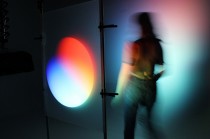
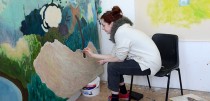
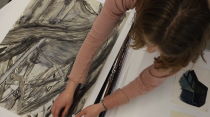









Comments